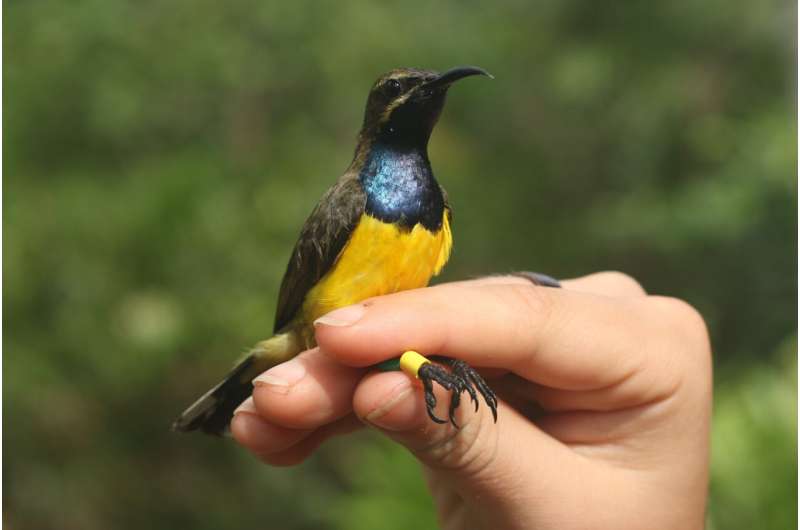Several beautiful new bird species found on remote Indonesian islands

Zoologists from Trinity College Dublin, working with a research team in Indonesia, have found several new species of colorful, tropical sunbirds.
The zoologists have identified a new species, the Wakatobi sunbird (Cinnyris infrenatus), which lives on the tiny Wakatobi Islands in central Indonesia. They also examined the more widespread olive-backed sunbirds and black sunbirds, and found that individuals named as such actually belonged to multiple unrecognized species.
In combination, these exciting findings have important implications for our understanding of evolution in this biodiverse region.
Living in the tropics from Africa to Australia, sunbirds look similar to the American hummingbirds and fill a similar ecological niche. Male sunbirds often have bright plumage, with iridescent or "metallic" feathers that shine in the sunlight.
For hundreds of years zoologists have examined sunbirds' plumage to name species, over 140 of which are currently recognized. However, by using new forms of evidence, including DNA, song recordings, and statistical analyses of body measurements, the zoologists have revealed that this family is even more diverse than had been realized.
This work was carried out jointly by researchers from Trinity's School of Natural Sciences and from Universitas Halu Oleo in Sulawesi, Indonesia, and has just been published in the Zoological Journal of the Linnean Society. Fittingly, this journal was the first to publish the evolutionary theories of Charles Darwin and Alfred Russel Wallace back in 1858.

The international research team retraced Wallace's steps in more ways than one, as he based his theories on his studies of animals across the islands of present-day Indonesia.
Fionn Ó Marcaigh, first author on the paper and a Ph.D. Candidate in Trinity's School of Natural Sciences, said, "One of Wallace's major findings is referred to as 'Wallace's Line'—a boundary between deep and shallow seas that many animals have been unable to cross, leading to marked differences in the species found on either side. The widespread olive-backed sunbird appeared to be an exception, being found all the way from China to Australia with Wallace's Line right in the middle of its range.
"The new study, however, has shown that the populations on either side actually represent two different species, in keeping with Wallace's original predictions. The black sunbird was already known to be subject to Wallace's Line, but the new research has shown that the population around Sulawesi is a separate species from the one in New Guinea."
Despite this split, the olive-backed sunbird covers quite a wide range for such a small bird. The newly discovered Wakatobi sunbird, on the other hand, is restricted to the tiny Wakatobi Islands, off the coast of the larger Sulawesi. Small, isolated islands like these have their own evolutionary processes, and these often produce unique species, as in the famous case of the Galápagos.
Previous work from the Trinity School of Natural Sciences identified two species of white-eye birds from the same area, which has been recognized by international conservation organizations as a Key Biodiversity Area.

As well as being genetically unique, the Wakatobi sunbird also has darker plumage, a higher-pitched song, and shorter wings than the olive-backed sunbird. Its short wings probably contributed to its remaining isolated on the Wakatobi Islands while the olive-backed sunbird was undertaking long-distance colonization over the sea.
Fionn Ó Marcaigh added, "It's amazing that there are still species waiting to be found in this region, which has been important to evolutionary biology since the time of Wallace. I'm thrilled that we've added to the list of known species from this wonderful part of the world, it's the kind of thing I dreamed of when I first got interested in zoology as a child. As well as that, this study has been a brilliant opportunity to build on classic work with new techniques. It's especially fascinating when we find new discoveries that support Wallace's original predictions."
Dr. David Kelly of Trinity University is the second author on the paper. He added, "The identification of the Wakatobi sunbird serves to remind us that biodiversity is everywhere. This bird wasn't found in a remote rainforest, but along the scrubby margins of busy towns and villages. Let us hope the children of the Wakatobi will be able to enjoy these special birds for generations to come."
More information: Fionn Ó Marcaigh et al, Small islands and large biogeographic barriers have driven contrasting speciation patterns in Indo-Pacific sunbirds (Aves: Nectariniidae), Zoological Journal of the Linnean Society (2022). DOI: 10.1093/zoolinnean/zlac081
Journal information: Zoological Journal of the Linnean Society
Provided by Trinity College Dublin
















